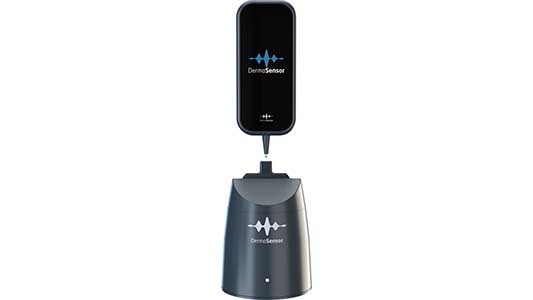DermaSensor Inc., a health technology company equipping primary care physicians (PCPs) with a non-invasive device for use in evaluation of suspicious skin lesions, presented a pooled analysis today from two clinical studies evaluating the performance of the company’s device in detecting skin cancer. In the DERM-ASSESS III and DERM-SUCCESS clinical studies, the device had a sensitivity of 94% for correctly classifying the 338 high risk lesions and a specificity of 23% for correctly classifying 1,681 low risk lesions, all of which were biopsied by physicians for suspicion of skin cancer. Underscoring the effectiveness of DermaSensor’s non-invasive, optical spectroscopy technology, the device met its primary endpoint in the pivotal study (DERM-SUCCESS) of having higher sensitivity than PCPs for all common skin cancers.
“DermaSensor’s technology will help primary care physicians detect cancerous skin lesions and refer those patients appropriately to a dermatologist,” said Dr. Jane Grant-Kels, who is last author on this AAD publication of these studies and is a Professor and founding Chair emeritus of the Department of Dermatology at the University of Connecticut (UConn) Health Center and Medical School. “Prompt referral from a PCP to a dermatologist can help minimize patient mortality, morbidity and result in the saving of health care dollars.” Dr. Grant-Kels is the 2023 recipient of the Clarence S. Livingwood, MD, Memorial Award and Lectureship from the AAD and is a member of DermaSensor’s Scientific Advisory Board.
Skin cancer is the most common form of cancer in the US, and melanoma is expected to be the second most common cancer in the US by 2040 [1]. There are also over 200,000 PCPs in the United States who are well-positioned to detect and refer these skin cancers. The DermaSensor device is designed as an objective, non-invasive tool that can be used by PCPs during an exam to support the rapid, point-of-care assessment of lesions suggestive of skin cancer. The device was granted FDA Breakthrough Device designation and is currently under review by the FDA.
“It is an honor to have been selected to present data at the AAD from our two major clinical validation studies, which are two of our four studies serving as principal support for our FDA submission,” said DermaSensor’s CEO, Cody Simmons. “Having spent a decade miniaturizing and conducting studies with our spectroscopy technology, we hope to soon equip PCPs in the U.S. with our handheld, wireless device in order to improve their detection and referral of skin cancer, which is more common than all other cancers combined.”
Across both studies, over 2,000 suspicious lesions were biopsied by 32 study centers. The DERM-ASSESS III Study with 10 dermatology centers found a 96% device sensitivity for detecting melanoma (91% for all high risk melanocytic lesions) in the dermatology setting, and correctly classified 32.5% of benign lesions (i.e., specificity) that were biopsied by the study dermatologists for suspicion of melanoma. A negative device result had a 98% chance of being negative for melanoma while a positive device result was melanoma approximately one out of six times, showing that a positive device result had a higher risk for melanoma and is recommended for further evaluation by a dermatologist. Similarly, the DERM-SUCCESS Pivotal Study with 22 primary care study centers demonstrated 96% device sensitivity for all skin cancers in the primary care setting. The device specificity was 21% for correctly classifying benign lesions that were biopsied by the physicians. The device NPV was 97% and the PPV was 17%, i.e., one in six lesions with a positive device result were cancerous.
There were no device-related safety issues reported in either study. The studies included investigators and authors from Mayo Clinic, Harvard School of Medicine, Yale School of Medicine, University of Connecticut, Florida State University, Trinity University, and the Medical College of Georgia.












